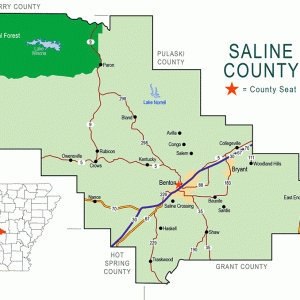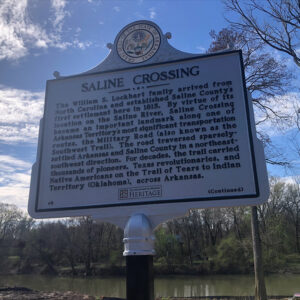calsfoundation@cals.org
Saline Crossing (Saline County)
aka: Saline Crossings
Saline Crossing was a community in Saline County that once vied for the position of county seat. During the late territorial period, in 1831, William Lockhart was granted the right to build a toll bridge there, although people could still ford the stream for free. This site was later used by Native American tribes during their removal through Arkansas until 1840. Every traveler following the Old Military Road or Southwest Trail from Little Rock (Pulaski County) to Rockport (Hot Spring County) crossed the Saline River at that location. In the twenty-first century, the area that once hosted the historical community lies around the Old River Bridge at the end of River Street in Benton (Saline County). No physical remnants of Saline Crossing exist.
William Lockhart (sometimes spelled Lockert) left North Carolina with his family to settle in the newly acquired Louisiana Territory in 1815. It is unknown exactly which route he took across the southeastern states, but he did follow the Southwest Trail through the heart of what is now Arkansas to an area where the Southwest Trail crossed the Saline River. Tribes such as the Quapaw and Caddo lived there at the time. Lockhart built a cabin on the Saline’s banks, making him the first white man to settle in present-day Saline County. He stayed there for the remaining thirty-two years of his life. In 1817, Abner Herold and his stepsons, Isham and John Pelton, settled near Lockhart’s home at what he called Saline Crossing. In 1819, Arkansas Territory was created by Congress, causing more white settlers to spill into the area. By 1820, the families of Robert and Valentine Brazil had settled there, along with those of James Buchan and Samuel Williams. Five years later, twelve families had made it from there to present-day Collegeville (Saline County) and Salem (Saline County) and then moved to settle what became Kentucky Township, as most of the people living there came from Kentucky.
The Reverend William Stephenson, a Methodist circuit rider, gave the first recorded sermon in Saline County at Lockhart’s cabin in 1817. Thomas Nuttall wrote that there were “nine or ten families living at Saline Crossing” and that the land was “fertile enough and healthy enough” to attract new settlers, which it did. The Southwest Trail that crossed the Saline River at that point was regarded as little more than an “obscure trail,” but by 1831 the road was considerably widened and improved after the Indian Removal Act was passed by Congress a year before.
In 1831, a post office opened at Saline Crossing with William Lockhart as its postmaster, and the Territorial Legislature granted Lockhart the right to operate a toll bridge there. Because of that, Saline Crossing and nearby Benton became important landmarks on the Southwest Trail. During Indian Removal, the area was on the route between Little Rock and Fort Towson in Indian Territory. On January 4, 1832, the Arkansas Gazette reported that a “party of Choctaws” who had left Camp Pope in Little Rock “left the Saline, 30 miles south of this, on Saturday morning last, and were proceeding on very finely when last heard from.” On November 23, 1832, removal agent S. T. Cross recorded crossing the Saline River in his Journal of Occurrences with this line: “Left camp and traveled twelve miles crossing Saline creek—but few cases of sickness.” In fact, that winter was one of the coldest on record, and a cholera epidemic quickly spread through the remaining groups. Many died from exposure and more from disease while crossing the Arkansas swamps to Indian Territory.
British geologist George William Featherstonhaugh visited Saline Crossing on November 27, 1834, where he reported being “27 miles from Little Rock” at a place “kept by a sort of she Caliban.” The house was a tenement consisting of a single room with a mud floor. Saline Crossing was considered for the county seat but ultimately lost to nearby Benton, which absorbed Saline Crossing’s post office. In November 1835, Saline County was created, and Benton was named its county seat. Many residents of Saline Crossing, including Green B. Hughes (another early settler in the county), moved farther inland. The post office at Saline Crossing was abolished on January 7, 1836, four months before one was established at Benton with Hughes as postmaster. Hughes later served in the Arkansas House of Representatives from 1846 to 1848.
The Chickasaws began to leave their homelands in Mississippi and Alabama in the summer of 1837. By August 12, the main group of Chickasaw families under the command of Agent John M. Millard was camped along the Saline River near the newly incorporated town of Benton. Millard stayed at George Ann Lockhart’s public house at Saline Crossing and at the home of Joseph Clift, from whom he bought fresh beef, corn, and salt.
An act of the Saline County Court appropriated $5,000 “for the construction of an iron bridge over the Saline River at the Military Road Crossing” in 1889. The Old River Bridge was completed in 1891 by Youngstown Bridge Company of Youngstown, Ohio. The land around the bridge is believed to be the site of Saline Crossing because the Military Road or Southwest Trail crosses the Saline River there. The bridge was shut down in 1974 when a truck fell through its wooden floor. The land around the bridge was privately owned and off limits to the public until 2011, when former Benton mayor Lynn A. Moore founded a nonprofit group called Saline Crossing Regional Park and Recreation Area, Inc., which announced its intention to preserve and restore both the bridge and grounds to form a regional park at the site where the Lockharts settled in 1815.
On March 25, 2018, it was announced in the Saline Courier that funding had been secured to begin the restoration process on the Old River Bridge and the area around it. Plans called for the bridge to be disassembled, restored, and reassembled in its original place as part of a hiking and biking trail leading from Little Rock to Hot Springs (Garland County) along what was once the Southwest Trail. On March 27, it was reported that the work will be done by Lockhart Ironworks of Ohio, a company run by descendants of William Lockhart.
For additional information:
Benton Courier Centennial Number, March 25, 1937, p. 3.
Dunnahoo, Pat. “Old Saline Crossing—It Pre-Dated Arkansas Territory.” Arkansas Gazette, October 12, 1969, p. 4E.
“Journal of S. T. Cross—Choctaw Removal, 1832.” Eyewitness Accounts. Sequoyah National Research Center. University of Arkansas at Little Rock, Little Rock, Arkansas. https://ualrexhibits.org/trailoftears/eyewitness-accounts/journal-of-st-cross-choctaw-removal-1832/. (accessed May 8, 2018).
Paige, Amanda, Fuller Bumpers, and Dr. Daniel F. Littlefield Jr. Chickasaw Removal. Ada, OK: Chickasaw Press, 2010.
Perry, Sarah. “Dream Come True – Efforts to restore river bridge set to begin.” Saline Courier. March 25, 2018, p. A1.
Perry, Sarah. “Strong Connection – Relatives of county settler chosen for bridge restoration.” Saline Courier. March 27, 2018, p. 1
“William S. Lockert.” Sequoyah National Research Center. University of Arkansas at Little Rock, Little Rock, Arkansas. https://ualrexhibits.org/trailoftears/people/william-s-lockert/. (accessed May 8, 2018).
Cody Lynn Berry
Benton, Arkansas
 Saline County Map
Saline County Map  Saline Crossing Plaque
Saline Crossing Plaque 




Comments
No comments on this entry yet.